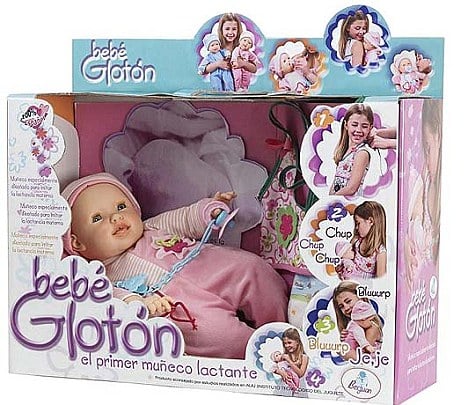
Now, a breastfeeding doll, soon to make its way to American toy stores, has added to the controversy. The doll is designed to mimic sucking noises as the child “nurses” it.
Parties from both sides of the issue have voiced their opinions. No one seems to meet in the middle. No one seems to agree. So where is the truth really?
One side claims that the doll is “sexualizing” little girls. Medical A-Team’s Dr. Keith Ablow stated that the doll is ridiculous and destructive saying,
“Little girls aren’t even aware of how their secondary sexual characteristics will develop, let alone imitating how they’ll be used after childbirth. This is another way of turning little girls into adults….it contributes to the sexualization of children and makes them targets of assailants, frankly.”
Yahoo Contributor Pamela Gifford supported Ablow’s position stating,
“To have mommies putting a doll to their daughters’ nipples to show them how to ‘feed’ the doll is quite disturbing; just as disturbing as those itty bitty bikinis you see in stores for 4-year-old….A breastfeeding doll puts an adult spin on an otherwise harmless kid’s toy.”
Gifford went on to say, “Women’s breasts are private in most parts of the world. Trying to convince little girls, who have no idea of the function of breasts and who don’t even have breasts, that they should mimic breastfeeding with a doll is a bit much.”
Not everyone is against the doll, however. There are some supporters – supporters like Mommy blogger and parenting expert Jennifer Gottlieb who stated that her own children mimicked her when she breastfed. “Children do what their parents do. It’s a part of normal development.”
Huffington Post writer Tessa Blake also made a supporting argument for the doll.
“Our medical institutions are in agreement that breastfeeding provides significant health benefits to babies and mothers…The only reason this doll is accused of sexualizing children is because we can’t unsexualize the breast.”
Blake refuted the idea that the doll was any more harmful to little girls than bottle-feeding baby dolls, play kitchens and toy strollers. She argued that, if these items that are most definitely “grown-up” are considered healthy and normal, there should be no problem with a doll that allows a daughter to mimic her mother’s breastfeeding.
Blake also shares a story with readers in her article stating that, in Europe, the breast is anything but private. This is a point that I think requires some more exploration since Gifford directly contradicted this statement.
Throughout most of Europe, people are open and comfortable with their bodies – so much so that few look twice when they see a bared breast. Bare breasts while nursing is a cultural norm in Africa. Are breasts REALLY private in most other countries or is that just what most people would like to think?
When it comes right down to it, I don’t think that the doll manufacturers ever intended to stir up such a fuss. I honestly believe that they were just trying to help little girls feel more like their breastfeeding mothers. After all, we have baby dolls that suck from a bottle with real sounds and movements – why not the most natural feeding method, the breast? While it is true that little girls do not understand the sexuality of the breast, those that have a breastfeeding mother understand their purpose.
Since my daughter was a little more than a year old, she knew that Mommy’s breasts were full of milk and that was how Mommy fed her brother. She was breastfed herself. At age three, she mimics breastfeeding on her own. I have never forced it upon her or suggested that she do so. Even her friends that come to visit mimic me. It is a natural thing – both breastfeeding and adult mimicking.
I don’t believe the breastfeeding doll was created for every little girl. I do think that there are parents that will find value in it. I don’t buy bottles for my daughter’s baby. It’s not that I have an issue with a mother bottle-feeding her infant. It’s that I prefer to nurse. I don’t want my daughter to grow up thinking that a bottle is the only “acceptable” way of feeding an infant.
Other nursing mothers feel the same way. They want to encourage breastfeeding for the future. I don’t believe this is forced. It is a natural occurrence. Little girls copy their mothers. I don’t bottle feed so why would I confuse my daughter and hand her a bottle for her babies?
I understand the fears and concerns on the other side though. Really, I do. We have predators on nearly every corner. Women in America today are made to feel inferior about every body part, including their breasts. Supermodels that we will never look like plaster every magazine shelf in America. Barbie dolls that have an all-to-perfect body are sold in every toy store in America and played with by our children. Many women today played with them as young girls.
How are women supposed to be comfortable with breasts when they are defined as sexual toys by culture? It’s not to say they can’t be but they have a primary, larger purpose. Breastfeeding is not a “secondary” purpose.
Rarely do we consider why we feel so strongly about something. Rarely do we question why situations anger us. What I have learned over the last few years is that anger, while a real and healthy emotion, is always fueled by an underlying emotion. If left undiscovered, we rob ourselves of growing from and understanding that anger and ourselves.
Maybe, the real key to the acceptance of breastfeeding and the breastfeeding doll rests in finding acceptance of who we are as women; to “unsexualize” the breasts and, in the words of Eve Ensler of the Vagina Monologues, learn to “love our tree.” If we can do that, maybe we can stop feeling threatened by tree of others and decide to let each mother choose what is best for their families as we choose what is best for our own.
Related Articles:
- CDC Report: Hospitals Fail to Encourage New Moms to Breastfeed
- Study Finds Recent Hypoallergenic Formula Claims Not True
- Nursing Mother of 2-Week-Old Infant Asked to Leave Bus







